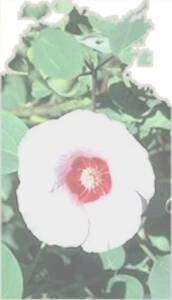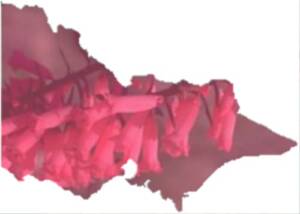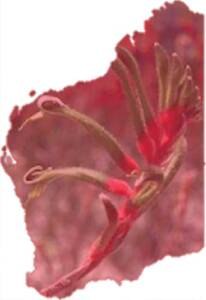Following are the floral emblems found in the national, states and territories of Australia.
Check out some of our listed amazing wildflowers to be found in Australia, with more being added over time, including more images on the flora to be found on the Australian emblems.
Golden Wattle
Flora emblem of the Commonwealth of Australia.

Golden Wattle (Acacia pycnantha)
Acacia pycnantha enjoyed popular acceptance as Australia’s national flower for much of this century but it was not proclaimed as the national floral emblem until 1988, the year of Australia’s bicentenary. The Gazettal is dated 1 September 1988, signed by the Governor General, Sir Ninian Stephen, on 19 August 1988.
A ceremony was held on 1 September 1988 at the Australian National Botanic Gardens when the Minister for Home Affairs, Robert Ray, made the formal announcement, and the Prime Minister’s wife, Mrs Hazel Hawke, planted a Golden Wattle.
Golden Wattle occurs in the understorey of open forest or woodland and in open scrub formations in South Australia, Victoria, New South Wales and the Australian Capital Territory, in temperate regions with mean annual rainfall of 350 mm to 1000 mm. It has been introduced into the Stirling Ranges near Perth where it threatens to become weedy.
Source: Australian National Botanic Gardens – Commonwealth floral emblem.
Royal Bluebell
Flora emblem of the Australian Capital Territory.

Royal Blue (Wahlenbergia gloriosa)
Officially announced as the floral emblem of the Australian Capital Territory on 26th May, 1982.
A sub-alpine woodland plant found in the high mountain areas of the ACT, south eastern NSW and eastern Victoria.
The genus ‘Wahlenbergia‘ was proposed by German botanist Heinrich Schrader, named in honour of Georg Goran Wahlenberg, Professor of Botany at Uppsala, Sweden. The species ‘gloriosa‘ is Latin for ‘superb‘ or ‘glorious‘.
Source: Australian National Botanic Gardens – ACT floral emblem.
Waratah
Flora emblem of New South Wales.

Waratah (Telopea speciosissima)
Was proclaimed the official floral emblem of New South Wales on 24th October, 1962.
The Aboriginal name ‘Waratah‘ meaning ‘red-flowering tree‘ was adopted by the early settlers at Port Jackson.
Telopea is derived from the Greek ‘telopos‘, meaning ‘seen from afar‘. Speciosissima is from the Latin ‘speciosus‘, meaning ‘beautiful‘ or ‘handsome‘.
Check out our page on the Waratah.
Source: Australian National Botanic Gardens – NSW floral emblem.
Sturt’s Desert Rose
Flora emblem of the Northern Territory.

Sturt’s Desert Rose (Gossypium sturtianum)
The Sturt’s Desert Rose was proclaimed floral emblem of the Northern Territory by the Commonwealth Government which was then responsible for the administration of the Territory on 12 July 1961. Proclamation was made using the name Cienfugosia gossypioides which is now replaced by the name Gossypium sturtianum var. sturtianum. In an Executive Statement in June 1975, the Majority Leader in the Legislative Assembly of the Northern Territory confirmed this species as the floral emblem. Since the granting of self-government to the Northern Territory in 1978, Sturt’s Desert Rose has been incorporated into various insignia and so become symbolic of the region.
The Sturt’s Desert Rose has also been known as Darling River Rose, Cotton Rosebush and Australian Cotton.
The generic name Gossypium, is derived from the Latin ‘gossypion’, used by Pliny for the cotton tree, Gossypium arboreum. The specific and varietal names, sturtianum, honour Captain Charles Sturt (1795-1869).
The species has undergone several changes in name, and in 1947 J.H. Willis of the National Herbarium of Victoria proposed the name by which it is currently known, Gossypium sturtianum var. sturtianum.
Check out our page on the Sturt’s Desert Rose (Gossypium sturtianum)
Source: Australian National Botanic Gardens – NT floral emblem.
Cooktown Orchid
Flora emblem of Queensland.

Cooktown Orchid (Dendrobium phalaenopsis)
On 19 November 1959 the Cooktown Orchid, under the botanical name of Dendrobium bigibbum var phalaenopsis, was proclaimed as the floral emblem of Queensland (Act). It conformed with the Government’s criteria in being an easily cultivated native species confined to Queensland, decorative and distinctive in appearance, and coloured close to the State colour, maroon.
The common name, Cooktown Orchid, refers to the northern Queensland town, Cooktown, which lies within the distribution of the species on the Endeavour River, named by Captain Cook after his ship was repaired there in 1770.
Source: Australian National Botanic Gardens – QLD floral emblem.
Sturt’s Desert Pea
Flora emblem of South Australia.

Sturt’s Desert Pea (Swainsona formosa)
Sturt’s Desert Pea, Swainsona formosa, was adopted as the floral emblem of South Australia on 23 November 1961, using the name Clianthus formosus.
A member of the pea family, Fabaceae, is confined to Australia, occuring in all mainland states except Victoria. The original collection was made in 1699 by William Dampier on Rosemary Island in the Dampier Archipelago.
Captain Charles Sturt (1795-1869) noted the occurrence of Swainsona formosa in 1844 while exploring between Adelaide and central Australia, and the common name, Sturt’s Desert Pea, commemorates a notable explorer of inland Australia, as well as indicating the plant’s habitat and family.
Check out our page on the Sturt’s Desert Pea (Swainsona formosa)
Source: Australian National Botanic Gardens – SA floral emblem.
Tasmanian Blue Gum
Flora emblem of Tasmania.

Tasmanian Blue Gum (Eucalpyptus globulus)
The Tasmanian Blue Gum, Eucalypts globulus, was proclaimed as the floral emblem of Tasmania on 27 November 1962.
Eucalyptus globulus was first collected on the south-east coast of Tasmania in 1792-93 by distinguished French botanist Jacques-Julien Houton de Labillardiere (1755-1834) and described by him in 1799.
Eucalyptus globulus now includes several subspecies of which E. globulus subsp. globulus is the Tasmanian emblem. The generic name Eucalyptus is derived from the Greek ‘eu‘, meaning ‘well‘, and ‘kalypto‘, meaning ‘to cover, as with a lid‘, referring to the operculum, a cap-like structure which protects the stamens in the bud and is shed when the flower opens.
Source: Australian National Botanic Gardens – TAS floral emblem.
Common Heath
Flora emblem of Victoria.

Common Heath (Epacris impressa)
The pink form of Common Heath, Epacris impressa, was proclaimed the floral emblem of Victoria on 11 November 1958. Victoria was the first Australian State to give official recognition to such an emblem.
The generic name Epacris is derived from the Greek ‘epi‘, meaning ‘upon‘, and ‘akris‘, meaning ‘a hill‘, referring to the elevated habitat of some species. The specific name impressa, Latin for ‘impressed‘ or ‘indented‘, refers to five dimples on the outside of the basal part of the floral tube.
Check out our page on the Common Heath (Epacris impressa)
Source: Australian National Botanic Gardens – VIC floral emblem.
Red and Green Kangaroo Paw
Flora emblem of Western Australia.

Red and Green Kangaroo Paw (Anigozanthos manglesii)
Red and Green Kangaroo Paw, Anigozanthos manglesii was proclaimed the floral emblem of Western Australia on 9 November 1960.
The author of the genus was the French botanist, Jacques-Julian Houton de Labillardiere, who was the first to collect the kangaroo paw, Anigozanthos rufus, near Esperance in 1792.
The generic name Anigozanthos is probably derived from the Greek ‘anises‘, meaning ‘unequal‘ or ‘oblique‘, and ‘anthos‘, meaning ‘flower‘, in reference to the division of the floral extremities into six unequal parts. The specific name, manglesii, honours Robert Mangles who raised the type specimen from seed in his English garden. The common name, kangaroo paw, is derived from the appearance of the unopened cluster of flowers.
Source: Australian National Botanic Gardens – WA floral emblem.
